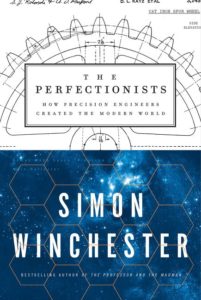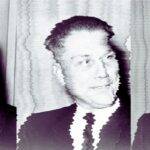
How My Father Introduced Me to Precision Engineering
On the Art of Turning Shapeless Hard Metal Into Objects of Beauty and Utility
The aim of science is not to open the door to infinite wisdom, but to set a limit to infinite error.
–Bertolt Brecht, Life of Galileo (1939)
![]()
We were just about to sit down to dinner when my father, a conspiratorial twinkle in his eye, said that he had something to show me. He opened his briefcase and from it drew a large and evidently very heavy wooden box.
It was a London winter evening in the mid-1950s, almost certainly wretched, with cold and yellowish smog. I was about ten years old, home from boarding school for the Christmas holidays. My father had come in from his factory in North London, brushing flecks of gray industrial sleet from the shoulders of his army officer’s greatcoat. He was standing in front of the coal fire to warm himself, his pipe between his teeth. My mother was bustling about in the kitchen, and in time she carried the dishes into the dining room.
But first there was the matter of the box.
I remember the box very well, even at this remove of more than 60 years. It was about ten inches square and three deep, about the size of a biscuit tin. It was evidently an object of some quality, well worn and cared for, and made of varnished oak. My father’s name and initials and style of address, B.A.W. WINCHESTER ESQ., were engraved on a brass plate on the top. Just like the much humbler pinewood case in which I kept my pencils and crayons, his box had a sliding top secured with a small brass hasp, and there was a recess to allow you to open it with a single finger.
This my father did, to reveal inside a thick lining of deep red velvet with a series of wide valleys, or grooves. Firmly secured within the grooves were a large number of highly polished pieces of metal, some of them cubes, most of them rectangles, like tiny tablets, dominoes, or billets. I could see that each had a number etched in its surface, almost all the numbers preceded by or including a decimal point—numbers such as .175 or .735 or 1.300. My father set the box down carefully and lit his pipe: the mysterious pieces, more than a hundred of them, glinted from the coal fire’s flames.
He took out two of the largest pieces and laid them on the linen tablecloth. My mother, rightly suspecting that, like so many of the items my father brought home from the shop floor to show me, they would be covered with a thin film of machine oil, gave a little cry of exasperation and ran back into the kitchen. She was a fastidious Belgian lady from Ghent, a woman very much of her time, and spotless linen and lace therefore meant much to her.
My father held the metal tiles out for me to inspect. He remarked that they were made of high-carbon stainless steel, or at least another alloy, with some chromium and maybe a little tungsten to render them especially hard. They were not at all magnetic, he added, and to make his point, he pushed them toward one another on the tablecloth—leaving a telltale oil trail to further upset my mother. He was right: the metal tiles showed no inclination to bond with each other, or to be repelled. Pick them up, my father said, take one in each hand. I took one in each palm and made as if to measure them. They were cold, heavy. They had heft, and were rather beautiful in the exactness of their making.
He then took the pieces from me and promptly placed them back on the table, one of them on top of the other. Now, he said, pick up the top one. Just the top one. And so, with one hand, I did as I was told—except that upon my picking up the topmost piece, the other one came along with it.
“Most of this work was secret, but once in a while he would smuggle me into one of his factories and I would gaze in either admiration or puzzlement at machines that cut and notched the teeth for tiny brass gearwheels . . .”
My father grinned. Pull them apart, he said. I grasped the lower piece and pulled. It would not budge. Harder, he said. I tried again. Nothing. No movement at all. The two rectangular steel tiles appeared to be stuck fast, as if they were glued or welded or had become one—for I could no longer see a line where one tile ended and the other began. It seemed as though one piece of steel had quite simply melted itself into the structure of the other. I tried again, and again.
By now I was perspiring from the effort, and my mother, back from the kitchen, was getting impatient, and so my father set his pipe aside and took off his jacket and began to dish out the food. The tiles were beside his water glass, symbols of my muscular impoverishment, my defeat. Could I have another try? I asked at dinner. No need, he said, and he picked them up and with a flick of his wrist simply slid one off the other, sideways. They came apart instantly, with ease and grace. I was openmouthed at something that, viewed from a schoolboy’s perspective, seemed much like magic.
No magic, my father said. All six of the sides, he explained, are just perfectly, impeccably, exactly flat. They had been machined with such precision that there were no asperities whatsoever on their surfaces that might allow air to get between and form a point of weakness. They were so perfectly flat that the molecules of their faces bonded with one another when they were joined together, and it became well-nigh impossible to break them apart from one another, though no one knows exactly why. They could only be slid apart; that was the only way. There was a word for this: wringing.
My father started to talk animatedly, excitedly, with a passionate intensity that I always liked. Metal tiles like these, he said, and with a very evident pride, are probably the most precise things that are ever made. They are called gauge blocks, or Jo blocks, after the man who invented them, Carl Edvard Johansson, and they are used for measuring things to the most extreme of tolerances—and the people who produce them work at the very summit of mechanical engineering. These are precious things, and I wanted you to see them, since they are so important to my life.
And with that said, he fell quiet, carefully put the gauge blocks back in their velvet-lined wooden box, finished his dinner, lit his pipe once more, and fell asleep by the fire.
*
My father was for all his working life a precision engineer. In the closing years of his career, he designed and made minute electric motors for the guidance systems of torpedoes. Most of this work was secret, but once in a while he would smuggle me into one of his factories and I would gaze in either admiration or puzzlement at machines that cut and notched the teeth for tiny brass gearwheels, or that polished steel spindles that seemed no thicker than a human hair, or that wound copper coils around magnets that seemed no bigger than the head of a pipe smoker’s vesta.
I remember with great fondness spending time with one of my father’s favored workers, an elderly man in a brown lab coat who, like my father, clasped a pipe between his teeth, leaving it unlit all the time he worked. He wore a permanently incised frown as he sat before the business end of a special lathe—German, my father said; very expensive—watching the cutting edge of a notching tool as it whirled at invisible speed, cooled by a constant stream of a cream-like oil-and-water mixture. The machine hunted and pecked at a small brass dowel, skimming as it did so microscopic coils of yellow metal from its edges as the rod was slowly rotated. I watched intently as, by some curiously magical process, an array of newly cut tiny teeth steadily appeared incised into the metal’s outer margins.
The machine stopped for a moment; there was a sudden silence—and then, as I squinted into the moving mass of confusion around the workpiece, a gathering of separate and more delicate tungsten carbide tools moved into view and were promptly engaged, and the spindles began to turn and cut, such that the teeth that had so far been created were now being shaped and curved and notched and chamfered, the machine’s magnifying glass showing just how the patterns of their edges evolved as they passed beneath the blades, until, with a whisper of disengagement, the spinning stopped, the dowel was sliced as a side of ham might be, the clamp was released, and out of a filter lifted from the cream-oil bath rose a dripping confection of impossibly shiny finished gearwheels, maybe 20 of them, each no more than a millimeter thick and perhaps a centimeter in diameter.
They were all flipped by an unseen leverout of the lathe and onto a tray, where they would lie ready to be slipped onto spindles and then attached in mysterious fashion to the motors that turned a fin here or varied the pitch of a screw there, with the gyroscopically ordered intention of keeping a high-explosive submarine weapon running straight and true toward its enemy target through the unpredictable movements of a cold and heaving sea.
“This phenomenon of precision, like oxygen or the English language, is something we take for granted, is largely unseen, can seldom be fully imagined, and is rarely properly discussed, at least by those of us in the laity.”
Except that, in this case, the elderly craftsman decided that the Royal Navy could easily spare one from this fresh batch of wheels. He took a pair of steel needle-nose tweezers and picked a sample out of the creamy bath, washed it under a gush of clear water, and handed it to me with an expression of pride and triumph. He sat back, smiled broadly at a job well done, and lit a satisfying pipe. The tiny gearwheel was a gift, my father would say, a reminder of your visit. As precise a gearwheel as you’ll ever see.
*
Just like his star employee, my father took singular pride in his profession. He regarded as profound and significant and worthy the business of turning shapeless slugs of hard metal into objects of beauty and utility, each of them finely turned and neatly finished and fitted for purposes of all imaginable kinds, prosaic and exotic—for as well as weaponry, my father’s plants built devices that went into motorcars and heating fans and down mineshafts; motors that cut diamonds and crushed coffee beans and sat deep inside microscopes, barographs, cameras, and clocks. Not watches, he said ruefully, but table clocks and ships’ chronometers and long-case grandfather clocks, where his gearwheels kept patient time to the phases of the moon and displayed it on the clock dials high up in a thousand hallways.
He would sometimes bring home pieces even more elaborate than but perhaps not quite as magical as the gauge blocks, with their ultra-flat, machined faces. He brought them primarily to amuse me, unveiling them at the dinner table, always to my mother’s chagrin, as they were invariably wrapped in oily brown wax paper that marked the tablecloth. Will you put that on a piece of newspaper? she’d cry, usually in vain, as by then the piece was out, shining in the dining room lights, its wheels ready to spin, its arms ready to be cranked, its glassware (for often there was a lens or two or a small mirror attached to the device) ready to be demonstrated.
My father had a great fascination with and reverence for well-made cars, most especially those made by Rolls-Royce. This at a time, long past, when these haughty machines represented not so much the caste of their owners as the craft of their makers. My father had once been granted a tour of the assembly line in Crewe and had spent a while with the team who made the engine crankshafts. What impressed him most was that these shafts, which weighed many scores of pounds, had been finished by hand and were so finely balanced that, once set spinning on a test bench, they had no inclination to stop spinning, since no one side was even fractionally heavier than another. Had there been no such phenomenon as friction, my father said, a Phantom V’s crankshaft, once set spinning, could run in perpetuity. As a result of that conversation, he had me try to design a perpetual motion machine of my own, a dream on which I wasted (given my then only very vague understanding of the first two laws of thermodynamics, and thus the impossibility of ever meeting the challenge) many hours of spare time and many hundreds of sheets of writing paper.
Though more than a half century has elapsed since those machine-happy days of my childhood, the memory still exerts a pull—and never more so than one afternoon in the spring of 2011, when I received, quite unexpectedly, an e-mail from a complete stranger in the town of Clearwater, Florida. It was headed simply “A Suggestion,” and its first paragraph (of three) started without frill or demur: “Why not write a book on the History of Precision?”
My correspondent was a man named Colin Povey, whose principal career had been as a scientific glassblower.* The argument he put forward was persuasive in its simplicity: precision, he said, is an essential component of the modern world, yet is invisible, hidden in plain sight. We all know that machines have to be precise; we all recognize that items that are of importance to us (our camera, our cellphone, our computer, our bicycle, our car, our dishwasher, our ballpoint pen) have to sport components that fit together with precision and operate with near perfection; and we all probably suppose that the more precise things are, the better they are. At the same time, this phenomenon of precision, like oxygen or the English language, is something we take for granted, is largely unseen, can seldom be fully imagined, and is rarely properly discussed, at least by those of us in the laity. Yet it is always there, an essential aspect of modernity that makes the modern possible.
Yet it hasn’t always been so. Precision has a beginning. Precision has a definite and probably unassailable date of birth. Precision is something that developed over time, it has grown and changed and evolved, and it has a future that is to some quite obvious and to others, puzzlingly, somewhat uncertain. Precision’s existence, in other words, enjoys the trajectory of a narrative, though it might well be that the shape of that trajectory will turn out to be more a parabola than a linear excursion into the infinite. In whichever manner precision developed, though, there was a story; there was, as they say in the moviemaking world, a through line.
![]()
* The few hundred members of this somewhat exclusive calling specialize in making glass instruments of great delicacy and complexity for use largely in chemical laboratories. They have a journal, Fusion; they hold conventions; and they have a hero, a Japanese American immigrant named Mitsugi Ohno, who, until his death in 1999 at age 73, worked mainly for Kansas State University and whose collection of enormous and detailed glass models of ships and iconic American buildings remains on the campus in the town of Manhattan. Ohno is most famous for having found a way to blow a Klein bottle, a recurving vessel that, like a three-dimensional version of a Möbius strip, has only a single surface.
__________________________________

From The Perfectionists: How Precision Engineers Created the Modern World. Used with permission of Harper. Copyright © 2018 by Simon Winchester.
Simon Winchester
Simon Winchester is the acclaimed author of many books, including The Professor and the Madman, The Men Who United the States, The Map That Changed the World, The Man Who Loved China, A Crack in the Edge of the World, and Krakatoa, all of which were New York Times bestsellers and appeared on numerous best and notable lists. In 2006, Winchester was made an officer of the Order of the British Empire (OBE) by Her Majesty the Queen. He resides in western Massachusetts.



















